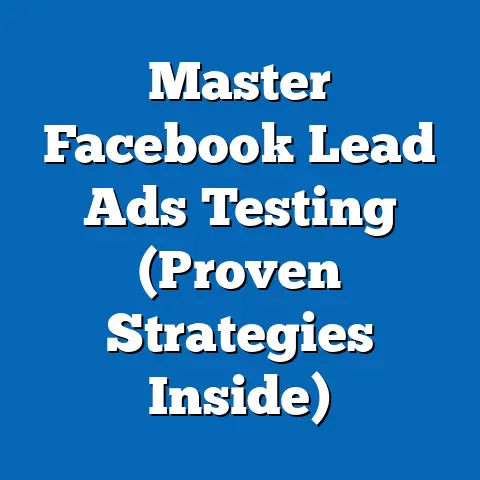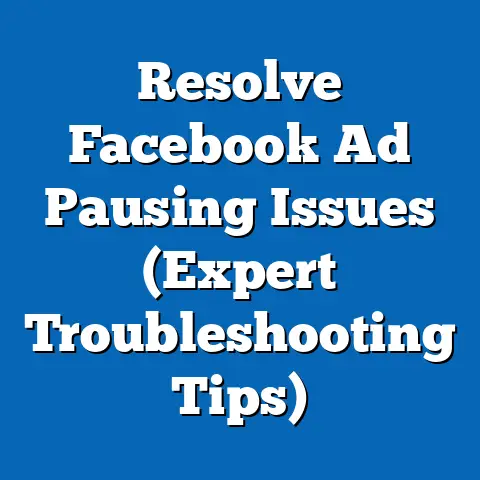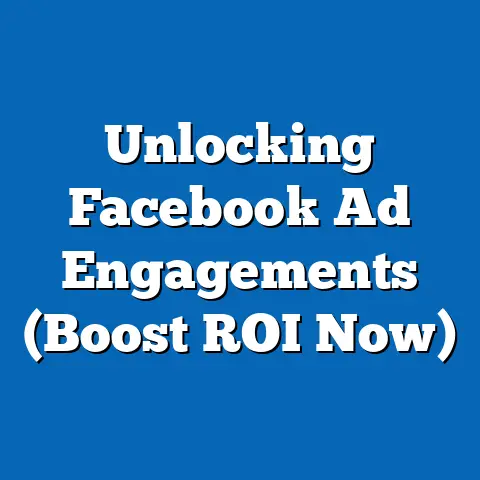Unlocking Facebook Ad Reports (Strategic Insights Revealed)
Imagine walking into a luxury boutique, the kind where every detail, from the lighting to the scent in the air, is meticulously crafted to create an unforgettable experience. That’s the power of effective advertising in the digital age. And just like a skilled artisan uses the finest materials to create a masterpiece, we, as marketers, can use Facebook Ads to build campaigns that resonate deeply with our target audience and elevate our brands to new heights.
Facebook advertising is no longer a simple game of casting a wide net and hoping for the best. It’s a sophisticated art, and like any art form, it requires a keen understanding of the tools at our disposal. One of the most invaluable tools in the Facebook advertising arsenal is the Facebook Ad Report. Think of it as the blueprint, the X-ray vision, the secret sauce that allows us to understand exactly what’s working, what’s not, and why.
In today’s fiercely competitive marketplace, data-driven decisions are not just an advantage, they’re a necessity. We can no longer rely on gut feelings or hunches. We need concrete evidence to guide our strategies, and that’s precisely what Facebook Ad Reports provide. They are a treasure trove of insights, waiting to be unlocked, that can transform our campaigns from mediocre to magnificent.
This article is your guide to unlocking that potential. I’m going to take you on a journey through the world of Facebook Ad Reports, showing you how to decipher the data, understand the key metrics, and use those insights to create advertising strategies that truly deliver results. Whether you’re a seasoned marketer or just starting out, this guide will equip you with the knowledge and tools you need to succeed. Let’s dive in!
Section 1: Understanding Facebook Ad Reports
So, what exactly are Facebook Ad Reports? In their simplest form, they’re a comprehensive overview of how your Facebook ad campaigns are performing. But they’re so much more than just a collection of numbers. They’re a window into the minds of your audience, a reflection of your creative choices, and a roadmap to achieving your advertising goals.
Think of them as a detailed post-game analysis for your advertising efforts. Just like a coach reviews game footage to identify strengths and weaknesses, you can use Facebook Ad Reports to understand what resonated with your audience, what fell flat, and how to improve your future campaigns.
The Components of Facebook Ad Reports
Facebook Ad Reports are comprised of various components, each offering a unique perspective on your ad performance. Understanding these components is crucial for interpreting the data and making informed decisions. Here are some of the key metrics you’ll encounter:
- Impressions: This is the number of times your ad was displayed to users, regardless of whether they clicked on it or not. It’s a measure of your ad’s reach and visibility.
- Reach: This is the number of unique users who saw your ad. While impressions count every time your ad is displayed, reach counts only the individual people who saw it.
- Clicks: This is the number of times users clicked on your ad, whether it was to visit your website, watch a video, or take another action.
- Click-Through Rate (CTR): This is the percentage of impressions that resulted in a click. It’s a measure of how engaging your ad is and how well it resonates with your target audience. (Clicks / Impressions) * 100 = CTR
- Cost Per Click (CPC): This is the average amount you paid for each click on your ad. It’s a measure of the efficiency of your ad spend. Total Spend / Clicks = CPC
- Conversions: This is the number of times users completed a desired action after seeing your ad, such as making a purchase, filling out a form, or subscribing to a newsletter. This is arguably the most important metric.
- Conversion Rate: This is the percentage of clicks that resulted in a conversion. It’s a measure of how effective your landing page is and how well it converts traffic into customers. (Conversions / Clicks) * 100 = Conversion Rate
- Cost Per Acquisition (CPA): This is the average amount you paid for each conversion. It’s a measure of the overall efficiency of your advertising campaign. Total Spend / Conversions = CPA
- Return on Ad Spend (ROAS): This is the revenue generated from your advertising campaign divided by the amount you spent. It’s a measure of the overall profitability of your advertising efforts. Revenue Generated / Total Spend = ROAS
Each of these metrics tells a different story about your ad performance. For example, a high number of impressions but a low CTR might indicate that your ad is reaching a large audience but isn’t engaging them effectively. Conversely, a low number of impressions but a high conversion rate might suggest that your ad is highly effective but isn’t reaching enough people.
Types of Facebook Ad Reports
Facebook offers a variety of ad reports, each designed to cater to different advertising goals and provide different insights. Here are some of the most common types of reports:
- Performance Reports: These reports provide a comprehensive overview of your ad performance, including metrics like impressions, reach, clicks, conversions, and ROAS. They’re a great starting point for understanding the overall effectiveness of your campaigns.
- Audience Insights: These reports provide detailed information about your target audience, including demographics, interests, behaviors, and purchase habits. They’re invaluable for understanding who you’re reaching and how to tailor your ads to their specific needs and preferences. I’ve used these insights to discover hidden interests and behaviors within my target audience that I never would have considered otherwise, leading to significant improvements in ad performance.
- Creative Reports: These reports analyze the performance of your ad creatives, including images, videos, and ad copy. They help you understand what’s resonating with your audience and what’s not, allowing you to optimize your creative for maximum impact.
- Placement Reports: These reports show you where your ads are being displayed on Facebook and Instagram, such as the news feed, stories, or right column. They help you understand which placements are performing best and optimize your ad delivery accordingly.
- Attribution Reports: These reports help you understand how different touchpoints in the customer journey contribute to conversions. They allow you to track the impact of your Facebook ads on offline sales, website visits, and other desired actions.
Each type of report offers a unique perspective on your ad performance, and by combining insights from different reports, you can gain a holistic understanding of your advertising efforts.
Takeaway: Facebook Ad Reports are a powerful tool for understanding your ad performance and making data-driven decisions. By understanding the different components of the reports and the types of reports available, you can unlock valuable insights that can transform your advertising strategies.
Next Steps: Familiarize yourself with the Facebook Ads Manager interface and explore the different types of reports available. Start by running a basic performance report to get a feel for the data and how it’s presented.
Section 2: Key Metrics and What They Mean
Now that we have a basic understanding of Facebook Ad Reports, let’s dive deeper into the key performance indicators (KPIs) that marketers should focus on. These metrics are the lifeblood of your advertising campaigns, providing critical insights into what’s working, what’s not, and how to optimize your efforts.
Essential Metrics Explained
Here’s a breakdown of some of the most essential metrics and what they mean for your advertising strategy:
-
Cost Per Click (CPC):
- Definition: The average amount you pay each time someone clicks on your ad.
- Why it’s important: It’s a direct measure of the efficiency of your ad spend. A lower CPC means you’re getting more clicks for your money.
- How to interpret it: A high CPC might indicate that your ad targeting is too broad, your ad copy isn’t compelling, or your ad relevance score is low. A low CPC suggests that your ad is resonating with your target audience and your targeting is effective.
- How it relates to other metrics: CPC is directly related to CTR and ad relevance. A higher CTR typically leads to a lower CPC, as Facebook rewards ads that are engaging and relevant to users.
-
Click-Through Rate (CTR):
-
Definition: The percentage of impressions that resulted in a click.
- Why it’s important: It’s a measure of how engaging your ad is and how well it resonates with your target audience. A higher CTR means your ad is capturing attention and prompting users to take action.
- How to interpret it: A low CTR might indicate that your ad copy is weak, your visuals are unappealing, or your targeting is off. A high CTR suggests that your ad is highly engaging and relevant to your audience.
- How it relates to other metrics: CTR directly impacts CPC and conversion rate. A higher CTR typically leads to a lower CPC and a higher conversion rate.
-
Conversion Rate:
-
Definition: The percentage of clicks that resulted in a conversion, such as a purchase, a form submission, or a lead generation.
- Why it’s important: It’s a measure of how effective your landing page is and how well it converts traffic into customers. A higher conversion rate means you’re turning more clicks into valuable actions.
- How to interpret it: A low conversion rate might indicate that your landing page is poorly designed, your offer isn’t compelling, or your website experience is confusing. A high conversion rate suggests that your landing page is optimized for conversions and your offer is appealing to your target audience.
- How it relates to other metrics: Conversion rate is directly related to CPA and ROAS. A higher conversion rate typically leads to a lower CPA and a higher ROAS.
-
Customer Acquisition Cost (CAC):
-
Definition: The average amount you pay to acquire a new customer through your advertising efforts.
- Why it’s important: It’s a measure of the overall efficiency of your advertising campaign. A lower CAC means you’re acquiring customers more cost-effectively.
- How to interpret it: A high CAC might indicate that your targeting is too broad, your ad creatives aren’t effective, or your landing page isn’t optimized for conversions. A low CAC suggests that your advertising campaign is highly efficient and you’re acquiring customers at a reasonable cost.
- How it relates to other metrics: CAC is directly related to CPA, conversion rate, and ROAS. Lowering your CPA and increasing your conversion rate will lead to a lower CAC.
-
Return on Ad Spend (ROAS):
-
Definition: The revenue generated from your advertising campaign divided by the amount you spent.
- Why it’s important: It’s a measure of the overall profitability of your advertising efforts. A higher ROAS means you’re generating more revenue for every dollar you spend on advertising.
- How to interpret it: A ROAS of 1 means you’re breaking even on your advertising spend. A ROAS greater than 1 means you’re generating a profit. A ROAS less than 1 means you’re losing money.
- How it relates to other metrics: ROAS is directly related to revenue, cost per acquisition, and ad spend. Increasing revenue and decreasing CAC will lead to a higher ROAS.
Cost Per Click (CPC):
- Definition: The average amount you pay each time someone clicks on your ad.
- Why it’s important: It’s a direct measure of the efficiency of your ad spend. A lower CPC means you’re getting more clicks for your money.
- How to interpret it: A high CPC might indicate that your ad targeting is too broad, your ad copy isn’t compelling, or your ad relevance score is low. A low CPC suggests that your ad is resonating with your target audience and your targeting is effective.
- How it relates to other metrics: CPC is directly related to CTR and ad relevance. A higher CTR typically leads to a lower CPC, as Facebook rewards ads that are engaging and relevant to users.
-
Click-Through Rate (CTR):
-
Definition: The percentage of impressions that resulted in a click.
- Why it’s important: It’s a measure of how engaging your ad is and how well it resonates with your target audience. A higher CTR means your ad is capturing attention and prompting users to take action.
- How to interpret it: A low CTR might indicate that your ad copy is weak, your visuals are unappealing, or your targeting is off. A high CTR suggests that your ad is highly engaging and relevant to your audience.
- How it relates to other metrics: CTR directly impacts CPC and conversion rate. A higher CTR typically leads to a lower CPC and a higher conversion rate.
-
Conversion Rate:
-
Definition: The percentage of clicks that resulted in a conversion, such as a purchase, a form submission, or a lead generation.
- Why it’s important: It’s a measure of how effective your landing page is and how well it converts traffic into customers. A higher conversion rate means you’re turning more clicks into valuable actions.
- How to interpret it: A low conversion rate might indicate that your landing page is poorly designed, your offer isn’t compelling, or your website experience is confusing. A high conversion rate suggests that your landing page is optimized for conversions and your offer is appealing to your target audience.
- How it relates to other metrics: Conversion rate is directly related to CPA and ROAS. A higher conversion rate typically leads to a lower CPA and a higher ROAS.
-
Customer Acquisition Cost (CAC):
-
Definition: The average amount you pay to acquire a new customer through your advertising efforts.
- Why it’s important: It’s a measure of the overall efficiency of your advertising campaign. A lower CAC means you’re acquiring customers more cost-effectively.
- How to interpret it: A high CAC might indicate that your targeting is too broad, your ad creatives aren’t effective, or your landing page isn’t optimized for conversions. A low CAC suggests that your advertising campaign is highly efficient and you’re acquiring customers at a reasonable cost.
- How it relates to other metrics: CAC is directly related to CPA, conversion rate, and ROAS. Lowering your CPA and increasing your conversion rate will lead to a lower CAC.
-
Return on Ad Spend (ROAS):
-
Definition: The revenue generated from your advertising campaign divided by the amount you spent.
- Why it’s important: It’s a measure of the overall profitability of your advertising efforts. A higher ROAS means you’re generating more revenue for every dollar you spend on advertising.
- How to interpret it: A ROAS of 1 means you’re breaking even on your advertising spend. A ROAS greater than 1 means you’re generating a profit. A ROAS less than 1 means you’re losing money.
- How it relates to other metrics: ROAS is directly related to revenue, cost per acquisition, and ad spend. Increasing revenue and decreasing CAC will lead to a higher ROAS.
Click-Through Rate (CTR):
Definition: The percentage of impressions that resulted in a click.
Conversion Rate:
Definition: The percentage of clicks that resulted in a conversion, such as a purchase, a form submission, or a lead generation.
Customer Acquisition Cost (CAC):
Definition: The average amount you pay to acquire a new customer through your advertising efforts.
Return on Ad Spend (ROAS):
Definition: The revenue generated from your advertising campaign divided by the amount you spent.
Real-Life Examples
Let’s look at a couple of hypothetical scenarios to illustrate the impact of these metrics:
-
Scenario 1: E-commerce Store
An e-commerce store is running a Facebook ad campaign to promote a new product. They spend $1,000 on ads and generate 1,000 clicks, resulting in a CPC of $1.00. They also generate 50 conversions, resulting in a conversion rate of 5%. Each conversion generates $50 in revenue, resulting in a total revenue of $2,500. Their ROAS is 2.5, meaning they’re generating $2.50 in revenue for every dollar they spend on advertising. * Scenario 2: Lead Generation Campaign
A business is running a Facebook ad campaign to generate leads for their sales team. They spend $500 on ads and generate 500 clicks, resulting in a CPC of $1.00. They also generate 25 leads, resulting in a conversion rate of 5%. Each lead is estimated to be worth $100 in potential revenue, resulting in a total potential revenue of $2,500. Their ROAS is 5, meaning they’re generating $5 in potential revenue for every dollar they spend on advertising.
Scenario 1: E-commerce Store
An e-commerce store is running a Facebook ad campaign to promote a new product. They spend $1,000 on ads and generate 1,000 clicks, resulting in a CPC of $1.00. They also generate 50 conversions, resulting in a conversion rate of 5%. Each conversion generates $50 in revenue, resulting in a total revenue of $2,500. Their ROAS is 2.5, meaning they’re generating $2.50 in revenue for every dollar they spend on advertising. * Scenario 2: Lead Generation Campaign
A business is running a Facebook ad campaign to generate leads for their sales team. They spend $500 on ads and generate 500 clicks, resulting in a CPC of $1.00. They also generate 25 leads, resulting in a conversion rate of 5%. Each lead is estimated to be worth $100 in potential revenue, resulting in a total potential revenue of $2,500. Their ROAS is 5, meaning they’re generating $5 in potential revenue for every dollar they spend on advertising.
These examples demonstrate how different metrics can be used to gauge the success of different types of advertising campaigns. By tracking these metrics closely and making data-driven adjustments, you can optimize your campaigns for maximum impact.
Takeaway: Understanding key metrics like CPC, CTR, conversion rate, CAC, and ROAS is crucial for gauging the success of your Facebook ad campaigns. By interpreting these metrics and understanding their relationships to each other, you can make informed decisions and optimize your campaigns for maximum impact.
Next Steps: Start tracking these key metrics for your own Facebook ad campaigns. Use the Facebook Ads Manager dashboard to monitor your performance and identify areas for improvement.
Section 3: Analyzing Audience Insights
One of the most powerful features of Facebook advertising is its ability to target specific audiences based on a wide range of demographics, interests, and behaviors. But simply targeting an audience isn’t enough. You need to understand who you’re targeting and how they’re responding to your ads. That’s where audience insights come in.
Audience insights are like a magnifying glass that allows you to zoom in on your target audience and understand their motivations, preferences, and online behavior. By analyzing this data, you can create more effective ad campaigns that resonate with your audience on a deeper level.
Accessing and Interpreting Audience Data
Accessing audience data from Facebook Ad Reports is relatively straightforward. Here’s how:
- Navigate to the Facebook Ads Manager.
- Select the ad campaign you want to analyze.
- Click on the “Breakdown” button.
- Choose the audience insights you want to view, such as demographics, interests, or behaviors.
Once you’ve accessed the audience data, you’ll be presented with a wealth of information about your target audience. Here are some of the key insights you can glean:
- Demographics: This includes information about your audience’s age, gender, location, education level, and relationship status. This data can help you understand the basic characteristics of your target audience and tailor your ad copy and visuals accordingly.
- Interests: This includes information about your audience’s interests, hobbies, and passions. This data can help you understand what your audience cares about and create ads that are relevant to their interests.
- Behaviors: This includes information about your audience’s online behavior, such as their purchase history, website visits, and app usage. This data can help you understand how your audience interacts with your brand and create ads that are tailored to their specific needs and preferences.
- Purchase Habits: This includes information about your audience’s purchase habits, such as their average order value, frequency of purchases, and preferred payment methods. This data can help you understand how your audience spends their money and create ads that are designed to drive sales.
Understanding Audience Segments
One of the most valuable aspects of audience insights is the ability to segment your audience based on different characteristics. By segmenting your audience, you can create more targeted ad campaigns that are tailored to the specific needs and preferences of each segment.
For example, you might segment your audience based on age, gender, or location. You could then create different ad campaigns for each segment, with ad copy and visuals that are specifically designed to resonate with that group.
I once worked with a client who was selling a line of skincare products. By segmenting their audience based on age, we were able to create different ad campaigns for different age groups. For younger audiences, we focused on acne prevention and blemish control. For older audiences, we focused on anti-aging and wrinkle reduction. This resulted in a significant increase in ad engagement and sales.
Examples of Successful Audience Insight Utilization
Here are some examples of brands that have successfully utilized audience insights to enhance engagement and drive conversions:
- Netflix: Netflix uses audience insights to understand what types of shows and movies their subscribers are interested in. They then use this data to recommend relevant content to their subscribers, increasing engagement and retention.
- Spotify: Spotify uses audience insights to understand what types of music their users are listening to. They then use this data to create personalized playlists and recommendations, increasing user engagement and satisfaction.
- Amazon: Amazon uses audience insights to understand what types of products their customers are interested in. They then use this data to recommend relevant products to their customers, increasing sales and revenue.
These examples demonstrate how powerful audience insights can be when used effectively. By understanding your audience’s demographics, interests, behaviors, and purchase habits, you can create more targeted ad campaigns that resonate with them on a deeper level and drive meaningful results.
Takeaway: Analyzing audience insights is crucial for shaping effective Facebook ad strategies. By accessing and interpreting audience data from Facebook Ad Reports, you can understand your audience’s demographics, interests, behaviors, and purchase habits, allowing you to create more targeted and engaging ad campaigns.
Next Steps: Start analyzing the audience insights for your own Facebook ad campaigns. Use the Facebook Ads Manager dashboard to access audience data and identify key segments within your target audience.
Section 4: Leveraging Creative Insights
While targeting the right audience is crucial, it’s only half the battle. The other half is creating compelling ad creatives that capture attention, communicate your message effectively, and drive desired actions. Your ad’s visuals, copy, and call-to-action (CTA) all play a vital role in its overall performance.
Creative insights help you understand how these elements are performing and identify areas for improvement. By analyzing creative performance through Facebook Ad Reports, you can optimize your ad creatives for maximum impact.
The Role of Visuals, Copy, and Call-to-Action
Let’s break down the role of each of these creative elements:
- Visuals: Your ad’s visuals are the first thing that catches the eye of your target audience. They should be visually appealing, relevant to your brand, and representative of your product or service. A high-quality image or video can make a huge difference in your ad’s performance.
- Copy: Your ad copy is the text that accompanies your visuals. It should be concise, compelling, and persuasive. It should clearly communicate the benefits of your product or service and encourage users to take action.
- Call-to-Action: Your CTA is the button or link that encourages users to take a specific action, such as “Shop Now,” “Learn More,” or “Sign Up.” It should be clear, concise, and action-oriented.
Each of these elements plays a crucial role in capturing audience attention and driving engagement.
Analyzing Creative Performance Through Facebook Ad Reports
Facebook Ad Reports provide a wealth of data on the performance of your ad creatives. Here are some of the key metrics you can use to analyze creative performance:
- Engagement Rate: This is the percentage of users who interacted with your ad in some way, such as liking, commenting, or sharing. A high engagement rate indicates that your ad is resonating with your audience and sparking conversation.
- Ad Relevance Score: This is a score that Facebook assigns to your ad based on its relevance to your target audience. A higher relevance score means that your ad is more likely to be seen by users who are interested in your product or service.
- Video Completion Rate: If you’re using video ads, this metric measures the percentage of users who watched your video to completion. A high video completion rate indicates that your video is engaging and holding viewers’ attention.
- Website Click-Through Rate: This is the percentage of users who clicked on the link in your ad to visit your website. A high website click-through rate indicates that your ad is effectively driving traffic to your website.
By analyzing these metrics, you can gain valuable insights into what’s working and what’s not with your ad creatives.
Case Studies of Effective Ad Creatives
Let’s look at a couple of case studies of effective ad creatives and how they influenced campaign outcomes:
- Dollar Shave Club: Dollar Shave Club is known for their humorous and engaging video ads. Their initial video ad went viral, generating millions of views and driving a huge surge in subscriptions. The ad was effective because it was funny, relatable, and clearly communicated the benefits of their product.
- Airbnb: Airbnb uses high-quality images and videos of their properties to showcase the unique experiences they offer. Their ads are visually appealing and create a sense of wanderlust, encouraging users to book a stay.
- Nike: Nike uses powerful storytelling in their ads to connect with their audience on an emotional level. Their ads often feature athletes overcoming challenges and achieving their goals, inspiring viewers to pursue their own dreams.
These examples demonstrate how effective ad creatives can drive campaign success. By focusing on creating visually appealing, compelling, and relevant ads, you can capture audience attention, drive engagement, and achieve your advertising goals.
Takeaway: Creative elements of ads significantly contribute to their overall performance. By analyzing creative performance through Facebook Ad Reports, focusing on metrics like engagement rates and ad relevance scores, you can optimize your ad creatives for maximum impact.
Next Steps: Start analyzing the creative performance of your own Facebook ad campaigns. Use the Facebook Ads Manager dashboard to access creative data and identify areas for improvement in your visuals, copy, and call-to-action.
Section 5: Strategic Adjustments Based on Data
The beauty of Facebook advertising is that it’s not a “set it and forget it” kind of activity. It’s an iterative process that requires continuous monitoring, analysis, and optimization. The insights you gather from Facebook Ad Reports are not just interesting data points; they’re actionable intelligence that can guide your strategic adjustments and improve your campaign performance.
The Importance of Continuous Optimization
Think of your Facebook ad campaigns as a living, breathing organism. They’re constantly evolving based on the feedback they receive from your audience. If you’re not paying attention to that feedback, you’re missing out on valuable opportunities to improve your results.
Continuous optimization is the process of making data-driven adjustments to your ad campaigns based on the insights you gather from Facebook Ad Reports. This includes things like:
- A/B testing: Testing different versions of your ad creatives, targeting options, or landing pages to see which performs best.
- Budget allocation: Shifting your budget to the ad campaigns or ad sets that are performing best.
- Audience segmentation: Refining your audience targeting based on demographics, interests, or behaviors.
- Bidding strategies: Adjusting your bidding strategies to optimize for different goals, such as conversions, reach, or impressions.
By continuously optimizing your ad campaigns, you can improve your ROI, lower your CAC, and achieve your advertising goals more effectively.
Strategies for Data-Driven Decisions
Here are some specific strategies for making data-driven decisions based on the insights you gather from Facebook Ad Reports:
- Identify your top-performing ads: Use the Facebook Ads Manager dashboard to identify the ad campaigns and ad sets that are generating the most conversions, leads, or sales. Focus your budget and efforts on these top-performing ads.
- Analyze your underperforming ads: Identify the ad campaigns and ad sets that are not performing well. Analyze the data to understand why they’re not working. Are the ad creatives weak? Is the targeting off? Are the landing pages not optimized for conversions?
- Run A/B tests: Experiment with different versions of your ad creatives, targeting options, or landing pages to see which performs best. Use the Facebook Ads Manager’s A/B testing feature to easily create and track your tests.
- Refine your audience targeting: Use the audience insights from Facebook Ad Reports to refine your audience targeting. Identify the demographics, interests, and behaviors that are most likely to convert.
- Adjust your bidding strategies: Experiment with different bidding strategies to optimize for different goals. If you’re focused on conversions, try using a conversion-based bidding strategy. If you’re focused on reach, try using a reach-based bidding strategy.
The Iterative Nature of Advertising Campaigns
It’s important to remember that advertising campaigns are not static. They’re constantly evolving based on the feedback they receive from your audience. You need to be prepared to adapt your strategies as needed.
I’ve seen countless examples of campaigns that started off strong but eventually fizzled out. This is often because the advertiser didn’t adapt their strategies as the campaign progressed. They didn’t pay attention to the data, and they didn’t make the necessary adjustments.
The key is to remain agile and responsive to performance data. Don’t be afraid to experiment with new ideas and try different approaches. The more you test and learn, the better you’ll become at creating effective Facebook ad campaigns.
Examples of Successful Brand Pivots
Here are some examples of successful brands that have pivoted their strategies based on insights from their reports:
Takeaway: Continuous optimization based on insights gathered from Facebook Ad Reports is crucial. By making data-driven decisions, such as A/B testing, budget allocation, and audience segmentation, you can improve your ROI, lower your CAC, and achieve your advertising goals more effectively.
Next Steps: Implement a process for continuous optimization in your own Facebook ad campaigns. Set aside time each week to analyze your data, identify areas for improvement, and make the necessary adjustments.
Conclusion
We’ve reached the end of our journey through the world of Facebook Ad Reports, and I hope you’ve gained a newfound appreciation for the luxury of harnessing data to refine your advertising strategies. In today’s competitive marketplace, data is your most valuable asset. It’s the key to understanding your audience, optimizing your campaigns, and achieving your marketing goals.
Remember, Facebook Ad Reports are not just a collection of numbers. They’re a window into the minds of your audience, a reflection of your creative choices, and a roadmap to success. By taking the time to understand the data and make data-driven decisions, you can transform your advertising campaigns from mediocre to magnificent.
The transformative power of insights in driving brand success cannot be overstated. By understanding your audience’s demographics, interests, behaviors, and purchase habits, you can create more targeted and engaging ad campaigns that resonate with them on a deeper level and drive meaningful results.
So, I encourage you to delve into your Facebook Ad Reports with a strategic mindset. Don’t be intimidated by the data. Embrace it, analyze it, and use it to guide your decisions. Unlock the potential hidden within your data, and watch your advertising campaigns soar to new heights. The luxury of data-driven success is within your reach. Go out there and claim it!






